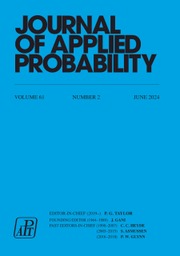No CrossRef data available.
Article contents
On the First Exit Time of a Nonnegative Markov Process Started at a Quasistationary Distribution
Published online by Cambridge University Press: 14 July 2016
Abstract
Core share and HTML view are not available for this content. However, as you have access to this content, a full PDF is available via the ‘Save PDF’ action button.
Let {Mn}n≥0 be a nonnegative time-homogeneous Markov process. The quasistationary distributions referred to in this note are of the form QA(x) = limn→∞P(Mn ≤ x | M0 ≤ A, M1 ≤ A, …, Mn ≤ A). Suppose that M0 has distribution QA, and define TAQA = min{n | Mn > A, n ≥ 1}, the first time when Mn exceeds A. We provide sufficient conditions for QA(x) to be nonincreasing in A (for fixed x) and for TAQA to be stochastically nondecreasing in A.
Keywords
MSC classification
- Type
- Research Article
- Information
- Copyright
- Copyright © Applied Probability Trust 2011
References
[1]
Borovkov, A. A. (1976). Stochastic Processes in Queuing Theory. Springer, New York.CrossRefGoogle Scholar
[2]
Harris, T. E. (1963). The Theory of Branching Processes. Springer, Berlin.CrossRefGoogle Scholar
[3]
Moustakides, G. V., Polunchenko, A. S. and Tartakovsky, A. G. (2011). A numerical approach to performance analysis of quickest change-point detection procedures. Statistica Sinica
21, 571–598.Google Scholar
[4]
Pollak, M. (1985). Optimal detection of a change in distribution. Ann. Statist.
13, 206–227.Google Scholar
[5]
Pollak, M. and Siegmund, D. (1986). Convergence of quasistationary to stationary distributions for stochastically monotone Markov processes. J. Appl. Prob.
23, 215–220.Google Scholar
[6]
Pollett, P. K. (2008). Quasi-stationary distributions: a bibliography. Available at www.maths.uq.edu.au/∼pkp/papers/qsds/qsds.pdf.Google Scholar
[7]
Tartakovsky, A. G., Pollak, M. and Polunchenko, A. S. (2011). Third-order asymptotic optimality of the generalized Shiryaev–Roberts changepoint detection procedures. To appear in Theory Prob. Appl.
Google Scholar


